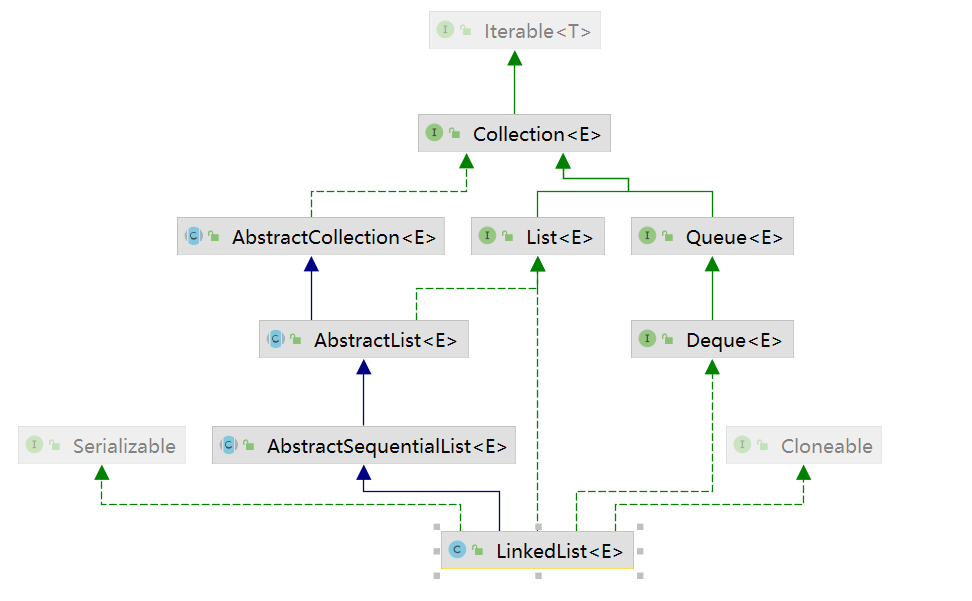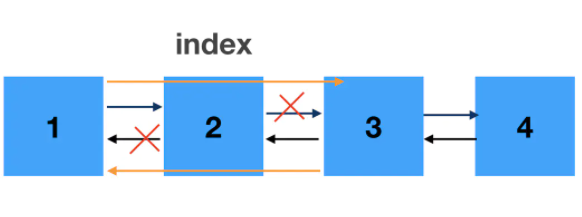LinkedList-源码
概述
LinkedList继承自AbstrackSequentialList并实现了List接口以及Deque双向队列接口,因此 LinkedList 不但拥有 List 相关的操作方法,也有队列的相关操作方法。LinkedList和ArrayList一样实现了序列化接口Serializable和Cloneable接口使其拥有了序列化和克隆的特性。- 继承了
AbstractSequentialList抽象类,在遍历的时候,推荐使用迭代器进行遍历。
但是只支持浅克隆,在LinkedList类中,其中的内部类Node并没有被克隆,只是调用了Object类中的clone方法进行可克隆。

LinkedList 双向链表实现及成员变量
核心组成:用来存储数据的结点,在LinkedList中设计成了内部类。
private static class Node<E> {
// 当前节点的元素值
E item;
// 下一个节点的索引
Node<E> next;
// 上一个节点的索引
Node<E> prev;
Node(Node<E> prev, E element, Node<E> next) {
this.item = element;
this.next = next;
this.prev = prev;
}
}
LinkedList 主要成员变量有下边三个:
//LinkedList 中的节点个数
transient int size = 0;
//LinkedList 链表的第一个节点
transient Node<E> first;
//LinkedList 链表的最后一个节点
transient Node<E> last;
构造方法
LinkedList的构造方法只提供了两个:
/**
* 空参数的构造由于生成一个空链表 first = last = null
*/
public LinkedList() {
}
/**
* 传入一个集合类,来构造一个具有一定元素的 LinkedList 集合
* @param c 其内部的元素将按顺序作为 LinkedList 节点
* @throws NullPointerException 如果 参数 collection 为空将抛出空指针异常
*/
public LinkedList(Collection<? extends E> c) {
this();
addAll(c);
}
带参数的构造方法,调用 addAll(c) 这个方法,
public boolean addAll(Collection<? extends E> c) {
return addAll(size, c);
}
实际上这方法调用了 addAll(size, c) 方法,
/**
* 在 index 节点前插入包含所有 c 集合元素的节点。
* 返回值表示是否成功添加了对应的元素.
*/
public boolean addAll(int index, Collection<? extends E> c) {
// 查看索引是否满足 0 =< index =< size 的要求
checkPositionIndex(index);
// 调用对应 Collection 实现类的 toArray 方法将集合转为数组
Object[] a = c.toArray();
//检查数组长度,如果为 0 则直接返回 false 表示没有添加任何元素
int numNew = a.length;
if (numNew == 0)
return false;
// 保存 index 当前的节点为 succ,当前节点的上一个节点为 pred
Node<E> pred, succ;
// 如果 index = size 表示在链表尾部插入
if (index == size) {
succ = null;
pred = last;
} else {
succ = node(index);
pred = succ.prev;
}
// 遍历数组将对应的元素包装成节点添加到链表中
for (Object o : a) {
@SuppressWarnings("unchecked") E e = (E) o;
Node<E> newNode = new Node<>(pred, e, null);
//如果 pred 为空表示 LinkedList 集合中还没有元素
//生成的第一个节点将作为头节点 赋值给 first 成员变量
if (pred == null)
first = newNode;
else
pred.next = newNode;
pred = newNode;
}
// 如果 index 位置的元素为 null 则遍历数组后 pred 所指向的节点即为新链表的末节点,赋值给 last 成员变量
if (succ == null) {
last = pred;
} else {
// 否则将 pred 的 next 索引指向 succ ,succ 的 prev 索引指向 pred
pred.next = succ;
succ.prev = pred;
}
// 更新当前链表的长度 size 并返回 true 表示添加成功
size += numNew;
//fast-fail
modCount++;
return true;
}
addAll(c)在外部单独调用时,将指定集合的元素作为节点,添加到 LinkedList 链表尾部。
而 addAll(size, c) 可以将集合元素插入到指定索引节点。
对于 checkPositionIndex方法这里想顺带分析了,
LinkedList 中有两个方法用于检查角标越界,内部实现一样。
private boolean isElementIndex(int index) {
return index >= 0 && index < size;
}
private boolean isPositionIndex(int index) {
return index >= 0 && index <= size;
}
都是通过 index >= 0 && index <= size 判断。
LinkedList 的增删改查
LinkedList 可以方便的在头尾插入一个节点,而 add 方法默认在链表尾部添加节点:
添加节点
public void addFirst(E e) {
linkFirst(e);
}
public void addLast(E e) {
linkLast(e);
}
public boolean add(E e) {
linkLast(e);
return true;
}
/**
* 在指定 index 位置插入节点
*/
public void add(int index, E element) {
// 检查角标是否越界
checkPositionIndex(index);
// 如果 index = size 代表是在尾部插入节点
if (index == size)
linkLast(element);
else
linkBefore(element, node(index));
}
可以看到默认是“尾插”,有返回值。
linkXXX
我们可以看到 add 方法是有返回值的,这个可以注意下。
看来这一系方法都调用用了 linkXXX 方法。
/**
* 添加一个元素在链表的头节点位置
*/
private void linkFirst(E e) {
// 添加元素之前的头节点
final Node<E> f = first;
//以添加的元素为节点值构建新的头节点 并将 next 指针指向 之前的头节点
final Node<E> newNode = new Node<>(null, e, f);
// first 索引指向将新的节点
first = newNode;
// 如果添加之前链表空则新的节点也作为未节点
if (f == null)
last = newNode;
else
f.prev = newNode;//否则之前头节点的 prev 指针指向新节点
size++;
modCount++;//操作数++
}
/**
* 在链表末尾添加一个节点
*/
void linkLast(E e) {
final Node<E> l = last;//保存之前的未节点
//构建新的未节点,并将新节点 prev 指针指向 之前的未节点
final Node<E> newNode = new Node<>(l, e, null);
//last 索引指向末节点
last = newNode;
if (l == null)//如果之前链表为空则新节点也作为头节点
first = newNode;
else//否则将之前的未节点的 next 指针指向新节点
l.next = newNode;
size++;
modCount++;//操作数++
}
node(int index)
/**
* 返回一个非空节点,这个非空节点位于 index 位置
*/
Node<E> node(int index) {
// assert isElementIndex(index);
// 如果 index < size/2 则从0开始寻找指定角标的节点
if (index < (size >> 1)) {
Node<E> x = first;
for (int i = 0; i < index; i++)
x = x.next;
return x;
} else {
// 如果 index >= size/2 则从 size-1 开始寻找指定角标的节点
Node<E> x = last;
for (int i = size - 1; i > index; i--)
x = x.prev;
return x;
}
}
linkBefore(E e, Node succ)
void linkBefore(E e, Node<E> succ) {
// assert succ != null;
// 由于 succ 一定不为空,所以可以直接获取 prev 节点
final Node<E> pred = succ.prev;
// 新节点 prev 节点为 pred,next 节点为 succ
final Node<E> newNode = new Node<>(pred, e, succ);
// 原节点的 prev 指向新节点
succ.prev = newNode;
// 如果 pred 为空即头节点出插入了一个节点,则将新的节点赋值给 first 索引
if (pred == null)
first = newNode;
else
pred.next = newNode;//否则 pred 的下一个节点改为新节点
size++;
modCount++;
}
删除节点
remove()
/**
* 删除头节点
* @return 删除的节点的值 即 节点的 element
* @throws NoSuchElementException 如果链表为空则抛出异常
*/
public E removeFirst() {
final Node<E> f = first;
if (f == null)
throw new NoSuchElementException();
return unlinkFirst(f);
}
/**
* 删除尾节点
*
* @return 删除的节点的值 即 节点的 element
* @throws NoSuchElementException 如果链表为空则抛出异常
*/
public E removeLast() {
final Node<E> l = last;
if (l == null)
throw new NoSuchElementException();
return unlinkLast(l);
}
/**
* 删除指定索引位置的节点
*/
public E remove(int index) {
checkElementIndex(index);
return unlink(node(index));
}
/**
*删除从头节点其第一个与 o 相同的节点
*/
public boolean remove(Object o) {
// 区别对待 null 元素,比较元素时候使用 == 而不是 equals
if (o == null) {
for (Node<E> x = first; x != null; x = x.next) {
if (x.item == null) {
unlink(x);
return true;
}
}
} else {
for (Node<E> x = first; x != null; x = x.next) {
if (o.equals(x.item)) {
unlink(x);
return true;
}
}
}
return false;
}
unlink()
/**
* 移除头节点
*/
private E unlinkFirst(Node<E> f) {
// assert f == first && f != null;
// 头节点的 element 这里作为返回值使用
final E element = f.item;
// 头节点下个节点
final Node<E> next = f.next;
// 释放头节点的 next 指针,和 element 下次 gc 的时候回收这个内部类
f.item = null;
f.next = null; // help GC
// 将 first 索引指向新的节点
first = next;
// 如果 next 节点为空,即链表只有一个节点的时候,last 指向 null
if (next == null)
last = null;
else
next.prev = null; //否则 next 的 prev 指针指向 null
size--;//改变链表长度
modCount++;//修改操作数
return element;//返回删除节点的值
}
/**
* 移除未节点
*/
private E unlinkLast(Node<E> l) {
// assert l == last && l != null;
final E element = l.item;
//未节点的前一个节点,
final Node<E> prev = l.prev;
//释放未节点的内容
l.item = null;
l.prev = null; // help GC
//将 last 索引指向新的未节点
last = prev;
// 链表只有一个节点的时候,first 指向 null
if (prev == null)
first = null;
else
prev.next = null;
size--;
modCount++;
return element;
}
关于unlink的代码示意图:

/**
* Unlinks non-null node x.
*/
E unlink(Node<E> x) {
// assert x != null;
final E element = x.item;
//保存 index 节点的前后两个节点
final Node<E> next = x.next;
final Node<E> prev = x.prev;
// 如果节点为头节点,则做 unlinkFirst 相同操作
if (prev == null) {
first = next;
} else {//否则将上一个节点的 next 指针指向下个节点
prev.next = next;
// 释放 index 位置 prev 指针
x.prev = null;
}
// 如果节点为尾节点,则将 last 索引指向上个节点
if (next == null) {
last = prev;
} else {//否则下个节点 prev 指针指向上个节点
next.prev = prev;
x.next = null;
}
x.item = null;
size--;
modCount++;
return element;
}
clear 操作
/**
* Removes all of the elements from this list.
* The list will be empty after this call returns.
*/
public void clear() {
// 依次清除节点,帮助释放内存空间
for (Node<E> x = first; x != null; ) {
Node<E> next = x.next;
x.item = null;
x.next = null;
x.prev = null;
x = next;
}
first = last = null;
size = 0;
modCount++;
}
查询节点
LinkedList 查询节点的方法,可分为根据指定的索引查询,获取头节点,获取未节点三种。
值得注意的是,根据索引去获取节点内容的效率并不高,所以如果查询操作多余增删操作的时候建议用 ArrayList 去替代。
/**
* 根据索引查询
*
public E get(int index) {
checkElementIndex(index);
return node(index).item;
}
/**
* 返回 first 索引指向的节点的内容
*
* @return the first element in this list
* @throws NoSuchElementException 如果链表为空则抛出异常
*/
public E getFirst() {
final Node<E> f = first;
if (f == null)
throw new NoSuchElementException();
return f.item;
}
/**
* 返回 last 索引指向的节点的内容
*
* @return the last element in this list
* @throws NoSuchElementException 如果链表为空则抛出异常
*/
public E getLast() {
final Node<E> l = last;
if (l == null)
throw new NoSuchElementException();
return l.item;
}
修改节点
LinkedList 只提供了 set(int index, E element) 一个方法
public E set(int index, E element) {
// 判断角标是否越界
checkElementIndex(index);
// 采用 node 方法查找对应索引的节点
Node<E> x = node(index);
//保存节点原有的内容值
E oldVal = x.item;
// 设置新值
x.item = element;
// 返回旧的值
return oldVal;
}
元素查询
/*
* 返回参数元素在链表的节点索引,如果有重复元素,那么返回值为从头节点起的第一相同的元素节点索引,
* 如果没有值为该元素的节点,则返回 -1;
*
* @param o element to search for
* @return
*/
public int indexOf(Object o) {
int index = 0;
// 区别对待 null 元素,用 == 判断,非空元素用 equels 方法判断
if (o == null) {
for (Node<E> x = first; x != null; x = x.next) {
if (x.item == null)
return index;
index++;
}
} else {
for (Node<E> x = first; x != null; x = x.next) {
if (o.equals(x.item))
return index;
index++;
}
}
return -1;
}
/**
**返回参数元素在链表的节点索引,如果有重复元素,那么返回值为从尾节点起的第一相同的元素节点索引,
* 如果没有值为该元素的节点,则返回 -1;
*
* @param o element to search for
* @return the index of the last occurrence of the specified element in
* this list, or -1 if this list does not contain the element
*/
public int lastIndexOf(Object o) {
int index = size;
if (o == null) {
for (Node<E> x = last; x != null; x = x.prev) {
index--;
if (x.item == null)
return index;
}
} else {
for (Node<E> x = last; x != null; x = x.prev) {
index--;
if (o.equals(x.item))
return index;
}
}
return -1;
}
调用 indexOf 从头结点开始查询元素位置遍历完成后若 返回值 !=-1 则表示存在,反之不存在
public boolean contains(Object o) {
return indexOf(o) != -1;
}
LinkedList 作为双向队列的增删改查
Deque 这个双端队列就厉害了,它既可以实现栈的操作,也可以实现队列的操作,换句话说,实现了这个接口的类,既可以作为栈使用也可以作为队列使用。
我们来看下 Queue 给我们提供了的方法:
| 头部 | 头部 | 尾部 | 尾部 | |
|---|---|---|---|---|
| 插入 | addFirst(e) | offerFirst(e) | addLast(e) | offerLast(e) |
| 移除 | removeFirst() | pollFirst() | remveLast() | pollLast |
| 获取 | getFirst() | peekFirst() | getLast() | peekLast |
由于 Deque 接口继承 Queue 接口,当 Deque 当做队列使用时(FIFO),只需要在头部删除,尾部添加即可。我们现在复习下 Queue 中的方法及区别:
Queue的offer和add都是在队列中插入一个元素,具体区别在于,对于一些 Queue 的实现的队列是有大小限制的,因此如果想在一个满的队列中加入一个新项,多出的项就会被拒绝。此时调用add()方法会抛出异常,而offer()只是返回的 false。remove()和poll()方法都是从队列中删除第一个元素。remove()也将抛出异常,而poll()则会返回nullelement()和peek()用于在队列的头部查询元素。在队列为空时,element()抛出一个异常,而peek()返回null。
添加元素
// queue 的添加方法实现,
public boolean add(E e) {
linkLast(e);
return true;
}
// Deque 的添加方法实现,
public void addLast(E e) {
linkLast(e);
}
// queue 的添加方法实现,
public boolean offer(E e) {
return add(e);
}
// Deque 的添加方法实现,
public boolean offerLast(E e) {
addLast(e);
return true;
}
很明显 LinkedList 的大小并没有限制,所以在 LinkedList 中他们的实现并没有实质性不同。
删除元素
// Queue 删除元素的实现 removeFirst 会抛出 NoSuchElement 异常
public E remove() {
return removeFirst();
}
// Deque 的删除方法实现
public E removeFirst() {
final Node<E> f = first;
if (f == null)
throw new NoSuchElementException();
return unlinkFirst(f);
}
// Queue 删除元素的实现 不会抛出异常 如果链表为空则返回 null
public E poll() {
final Node<E> f = first;
return (f == null) ? null : unlinkFirst(f);
}
// Deque 删除元素的实现 不会抛出异常 如果链表为空则返回 null
public E pollFirst() {
final Node<E> f = first;
return (f == null) ? null : unlinkFirst(f);
}
获取元素
// Queue 获取队列头部的实现 队列为空的时候回抛出异常
public E element() {
return getFirst();
}
// Deque 获取队列头部的实现 队列为空的时候回抛出异常
public E getFirst() {
final Node<E> f = first;
if (f == null)
throw new NoSuchElementException();
return f.item;
}
// Queue 获取队列头部的实现 队列为空的时候返回 null
public E peek() {
final Node<E> f = first;
return (f == null) ? null : f.item;
}
// Deque 获取队列头部的实现 队列为空的时候返回 null
public E peekFirst() {
final Node<E> f = first;
return (f == null) ? null : f.item;
}



【推荐】国内首个AI IDE,深度理解中文开发场景,立即下载体验Trae
【推荐】编程新体验,更懂你的AI,立即体验豆包MarsCode编程助手
【推荐】抖音旗下AI助手豆包,你的智能百科全书,全免费不限次数
【推荐】轻量又高性能的 SSH 工具 IShell:AI 加持,快人一步
· Linux系列:如何用heaptrack跟踪.NET程序的非托管内存泄露
· 开发者必知的日志记录最佳实践
· SQL Server 2025 AI相关能力初探
· Linux系列:如何用 C#调用 C方法造成内存泄露
· AI与.NET技术实操系列(二):开始使用ML.NET
· 没有Manus邀请码?试试免邀请码的MGX或者开源的OpenManus吧
· 无需6万激活码!GitHub神秘组织3小时极速复刻Manus,手把手教你使用OpenManus搭建本
· C#/.NET/.NET Core优秀项目和框架2025年2月简报
· DeepSeek在M芯片Mac上本地化部署
· 葡萄城 AI 搜索升级:DeepSeek 加持,客户体验更智能